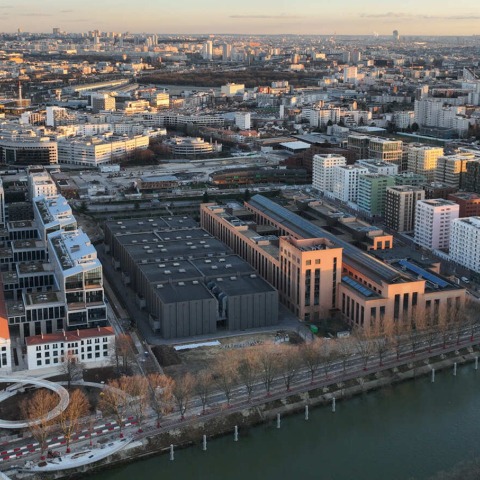
"District 2024" is a model developed by Dominique Perrault that compactly accommodates a set of functions that can be relocated to enrich different points of the metropolis through the image of the islands of boats, elements that invite the imagination of navigation, of the river and the landscape as links of identity.
The project exemplifies the three main themes chosen for the exhibition that develop the future of the Villa des Atletes: heritage, water and soil, elements that, through the Seine, which is an element of common identity, create a new district from an industrial wasteland ignored for ages that offers the opportunity to reconnect the city with the natural soil on the banks of the Seine.

The future of the Athletes' Village is beyond itself.
The Athletes' Village in the master plan is summarised by Perrault Architecture, as "two streets" anchored to the Seine River.
"The idea is very simple and very efficient. One street is more urban, with some buildings and some courtyards, going to the Seine River and connecting with a new bridge. The other one is more like a garden - it's a street from the public transport station to the Seine River with more presence of landscape. That's it."
Lining these "streets" is a cluster of apartment blocks, developed by a large group of architecture studios including Chaix et Morel, DREAM, Brenac & Gonzalez & Associés and CoBe Architecture et Paysage.
The Olympic and Paralympic Games are an opportunity for the international community, for Paris and its inhabitants: a strong social moment and a factor of intensification of urban development. In comparison, Greater Paris is synonymous with a field of possibilities.
Flagship projects such as the Olympic and Paralympic Village invite us to rethink the built form, imagined to host a temporary event, and housing, in light of the principles of evolutiveness, adaptability and reversibility.

The image of the islets-boats invites this imagination: a model adapted to a temporality and a given place, welcoming in a compact form a set of functions, capable of being transposed elsewhere, to enrich other places in the metropolis.
The islets-beauteaux also summon the imagination of navigation, and the images of the river and the landscape as identity links on a metropolitan scale. The geography of the Ile-de-France constitutes an element capable of giving the metropolis, and the landscape, a factor of coherence over time.
It is, of course, about designing a district capable of offering, temporarily, an exceptional welcome to athletes and their delegations. Still, it is a long-term urban reflection whose objective is to constitute a piece of Greater Paris, of this city-region that is undergoing an unprecedented transformation.
"Through the Athletes' Village, I wanted to present an unprecedented design approach, a process of revealing what exists, what has existed and what will exist. It is thanks to the establishment of "architects' workshops" bringing together the project management teams, the communities and the stakeholders of the territory that we have succeeded in going beyond the limits of the project's operating scope to better anchor it within its geography and its territory."
Dominique Perrault.








































